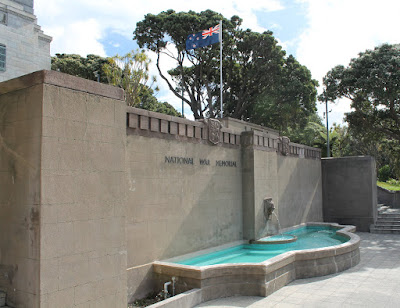In 1931 the steamer Ionic arrived at King's Wharf, Wellington. Her precious cargo included some of the big bells intended for temporary storage until the new Carillon was built.
On the afternoon of Anzac Day 1932 the National War Memorial Carillon was officially opened in front of a large audience of over 50,000 people at Buckle Street, Mount Cook, Wellington. Today its presence on the Wellington city's skyline is complemented by the Hall of Memories (1964) and the Tomb of the Unknown Warrior (2004) all of which are located at the Pukeahu National War Memorial Park opened in April 2015. What follows are a few early postcards of the Carillon, assorted newspaper information reporting on the grand occasion of its official opening and some personal photographs taken in recent years.
An early photographic postcard of the Carillon in Wellington taken by photographer Heaton Clairemont Peart. Note that the National Art Gallery and Dominion Museum buildings have not yet been built behind the tower. The Gallery and Museum were officially opened in 1936.
A view of the Carillon from Mt Victoria Tunnel taken by Heaton Clairemont Peart.

(source: Evening Post, 20 April 1932)

(source: Evening Post, 23 April 1932)



(source: Evening Post, 23 April 1932)

(source: Auckland Weekly News, 4 May 1932)

National War Memorial fountain and steps leading up to the Carillon. (2014)

War planes fly past the Carillon. Anzac Street Parade to Pukeahu War Memorial Park (24 April 2015).


Pukeahu War Memorial Park Sound and Light Show (2015)


Left: Wellington Anzac Dawn Service at the National War Memorial Carillon on 25 April 2015.
Right - Grand official opening of Pukeahu National War Memorial Park on 18 April 2015.







